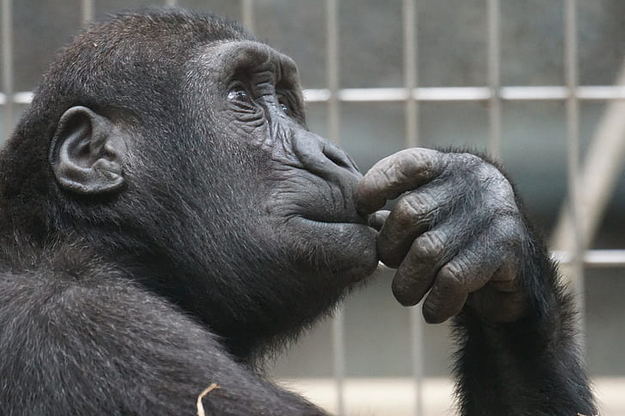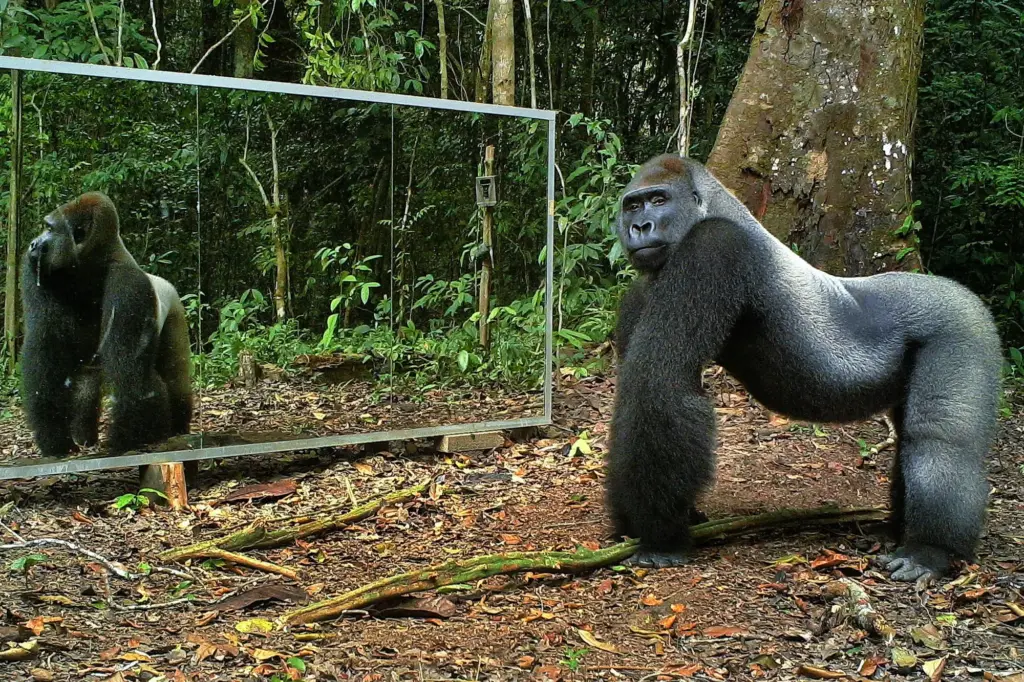
Understanding self-awareness in animals has long fascinated scientists, and for years, chimpanzees were considered to be among the few non-human species capable of recognizing themselves. However, groundbreaking new research now suggests that gorillas also exhibit a similar level of self-awareness.
Gorillas Display the Same Level of Self-Awareness as Chimpanzees
| Aspect | Details |
|---|---|
| Research Findings | Gorillas show self-awareness similar to chimpanzees |
| Test Used | Body-as-Obstacle (BAO) Task |
| Implications | Challenges traditional methods like the Mirror Self-Recognition test |
| Expert Opinion | Conducted by Utrecht University researchers |
| Additional Insight | Self-awareness is linked to higher problem-solving abilities and social intelligence |
| Future Research | More diverse methods needed to test self-awareness in different species |
The discovery that gorillas exhibit the same level of self-awareness as chimpanzees is a significant breakthrough in animal cognition research. By moving beyond traditional mirror tests and using alternative methods like the Body-as-Obstacle (BAO) task, scientists have opened the door to a deeper understanding of primate intelligence. These findings not only challenge past assumptions but also highlight the importance of expanding cognitive research in wildlife studies.
A New Perspective on Self-Awareness in Gorillas

For decades, self-awareness in animals has been measured using the Mirror Self-Recognition (MSR) test. This test determines whether an animal can recognize itself in a mirror by checking if it touches a mark placed on its body. Chimpanzees, dolphins, and even elephants have passed this test, but gorillas have shown inconsistent results—leading some researchers to believe they lack this ability.
However, recent studies suggest that the MSR test might not be the best way to measure self-awareness in all species. Gorillas, for instance, tend to avoid direct eye contact, which could make them less likely to engage with mirrors in the same way other animals do.
How Scientists Measured Self-Awareness in Gorillas

To overcome the limitations of the mirror test, researchers from Utrecht University introduced a new method: the Body-as-Obstacle (BAO) test. This experiment involved placing food inside a box that was sometimes blocked by the animal’s own body. The goal was to see whether the gorilla would recognize that its own body was preventing access to the food and adjust its position accordingly.
What the Study Found
- Gorillas quickly understood that their own bodies were in the way and moved to retrieve the food.
- Their reactions were similar to those of chimpanzees, a species already known for high cognitive abilities.
- This suggests that gorillas, like chimpanzees, possess a level of self-awareness that goes beyond what was previously believed.
- Observations indicate that gorillas displayed problem-solving behaviors beyond simple trial-and-error learning.
Why This Matters
These findings challenge long-standing assumptions about primate cognition and highlight the need for alternative testing methods. Instead of relying solely on mirror-based tests, researchers can now use behavioral experiments like the BAO test to gain deeper insights into self-awareness across different species.
The Science Behind Self-Awareness in Animals

Self-awareness is a complex cognitive trait often associated with intelligence, problem-solving, and social behavior. It is generally broken down into several stages:
1. Basic Self-Recognition
Animals understand that their body is separate from their environment. This can be observed in simple behaviors, such as avoiding obstacles.
2. Mirror Self-Recognition (MSR)
Some animals recognize themselves in a mirror and respond to a visible mark on their bodies.
3. Advanced Self-Awareness
This includes understanding one’s emotions, predicting future actions, and even empathy—traits often seen in great apes, dolphins, and elephants.
4. Self-Awareness in Social Contexts
Newer research suggests that self-awareness may also play a role in how animals interact with others, such as understanding social hierarchies, forming alliances, and recognizing the emotions of others.
How This Changes Our Understanding of Gorilla Intelligence

With these new findings, gorillas may now join the list of animals known to possess high-level cognitive skills. This has significant implications for:
- Animal Conservation: Understanding intelligence in animals can help improve enrichment programs in zoos and wildlife sanctuaries.
- Evolutionary Biology: Studying self-awareness in different species can provide insights into the evolution of cognition.
- Animal Rights: Recognizing advanced cognition in gorillas may strengthen arguments for better protection laws.
- Comparative Psychology: Expanding self-awareness studies can provide valuable insights into how cognition develops across species.
- Human Evolution Studies: This research can shed light on how self-awareness evolved in early human ancestors.
Future Research and Open Questions
While the BAO test offers a promising new way to study self-awareness in gorillas, more research is needed to:
- Test different primate species using a variety of self-awareness experiments.
- Analyze how self-awareness affects problem-solving and social behaviors in the wild.
- Determine whether other intelligent animals, like birds or marine mammals, would pass similar tests.
- Investigate the neurological basis of self-awareness using brain imaging studies.
Frequently Asked Questions (FAQs)
1. What is the Body-as-Obstacle (BAO) test?
The BAO test is a cognitive experiment that measures self-awareness by determining if an animal recognizes its own body as an obstacle to achieving a goal.
2. Why don’t gorillas pass the mirror test?
Unlike chimpanzees, gorillas tend to avoid direct eye contact, making them less likely to engage with their reflections. This could explain their inconsistent results in mirror self-recognition tests.
3. Does this mean gorillas are as intelligent as chimpanzees?
While intelligence varies across individuals and species, this study suggests that gorillas possess similar levels of self-awareness as chimpanzees, indicating comparable cognitive abilities.
4. How does this study affect conservation efforts?
Recognizing self-awareness in gorillas can lead to improved welfare policies, better conservation programs, and greater advocacy for their protection.
5. Could other animals also have self-awareness but fail the mirror test?
Yes! Many species may have self-awareness but do not engage with mirrors in ways that allow them to “pass” the test. For example, dogs and certain birds rely more on smell and sound rather than vision.










